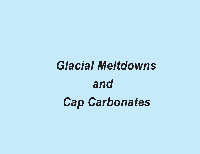 | 4.1:
Here are teaching slides for "Glacial Meltdowns & Cap Carbonates".
You can see a full-size version by clicking on the thumbnail. You can then
download that slide individually by right mouse clicking on it; using the "Save
As" command in the File menu; or in most cases, by simply dragging it to your
desktop.
|
|
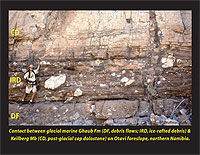 | 4.2:
Contact between the younger Cryogenian cap dolostone (CD) and proglacial
marine
deposits (DF, debris flows; IRD, ice-rafted debris) of the Ghaub Formation
(635 Ma), near Narachaams se Pos, southern foreslope of the Otavi Group,
Namibia.
|
|
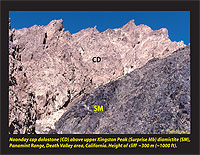 | 4.3:
Contact between the younger Cryogenian Noonday cap dolostone (CD) and glacial
marine
diamictite of the Surprise Member (SM), Goler Wash, Panamint Range, Death
Valley area, California.
|
|
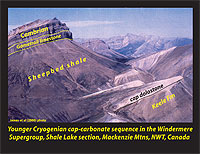 | 4.4:
Younger Cryogenian cap dolostone (Ravensthroat Formation) in the Shale
Lake area,
Mackenzie Mountains, northern Canadian Cordillera.
|
|
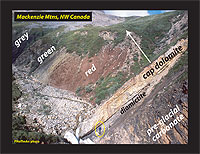 | 4.5:
Detail of younger Cryogenian glacial and post-glacial strata in the Arctic
Red
River section, Mackenzie Mountains, northern Canadian Cordillera.
|
|
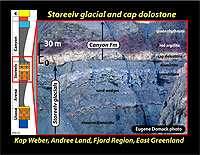 | 4.6:
Younger Cryogenian glacial and post-glacial strata in the Tillite Group
of the
East Greenland Caledonides.
|
|
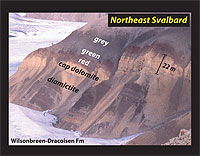 | 4.7:
Younger Cryogenian glacial and post-glacial strata in the Polarisbreen
Group of
the East Svalbard Caledonides.
|
|
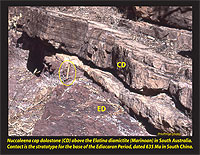 | 4.8:
Contact between the younger Cryogenian (Marinoan) cap dolostone (Nuccaleena
Formation)
and the Elatina Formation glacial-marine diamictite, Enorama Creek (GSSP
site), Flinders Range, South Australia.
|
|
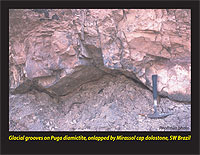 | 4.9:
Contact between the younger Cryogenian (Marinoan) cap dolostone (Mirassol
Formation)
and the Puga Formation glacial diamictite, Mirassol d’Oeste, Mato
Grosso, Brazil.
|
|
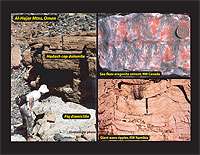 | 4.10:
Contact (left) between the younger Cryogenian (Marinoan) cap dolostone
(Hadash
Formation) and the Fiq Formation glacial diamictite, Wadi Hajir, Oman Mountains,
Oman. Characteristic structures in younger Cryogenian cap carbonates (right):
giant wave ripples in the Keilberg cap dolostone, NW Namibia, sea-floor
cements (former aragonite crystal fans) in the Hayhook cap limestone, NW
Canada.
|
|
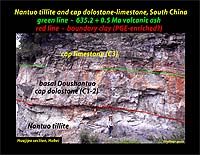 | 4.11:
Basal Ediacaran cap carbonate (lower Doushantuo Formation) in the Yangtze
Gorges area of South China. A thin clay-rich layer (red line) occurs between
the Nantuo glacigenic diamictite and the base of the cap dolostone (units
C1 and C2 of Jiang et al., 2005). An homologous layer in NW Canada contains
parts-per-billion levels of platinum group elements, or PGEs (Bernhard
Peucker-Ehrenbrink, personal communication). A thin volcanic tuff (green
line) lying directly on top of the cap dolostone has been dated at 635.2 ± 0.5
Ma by the ID-TIMS U-Pb zircon method (Condon et al., 2005), placing a tight
minimum constraint on the end of the Nantuo glaciation. The cap dolostone
is characterized by penecontemporaneous brecciation and barite precipitation,
possibly in the vadose zone. Overlying, deeper-water, marly limestone corresponds
to unit C3 of Jiang et al., 2005).
|
|
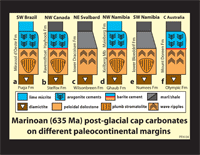 | 4.12:
Stratigraphic comparison of younger Cryogenian (Marinoan) cap carbonates
in Australia,
Brazil, Canada, Svalbard, NW Namibia (Congo craton), SW Namibia (Kalahari
craton), and Svalbard.
|
|
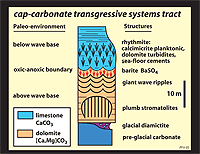 | 4.13:
Generic transgressive tract of the younger Cryogenian (Marinoan) cap-carbonate
sequence.
|
|
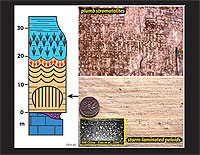 | 4.14:
Characteristic structures in younger Cryogenian (Marinoan) cap dolostones:
(below) graded
and reverse-graded peloids with low-angle cross lamination, Ravensthroat
Formation, NW Canada (inset: Tereeken cap dolostone, Quruqtagh, NW China);
plumb (tubular) stromatolite, Keilberg Member, NW Namibia.
|
|
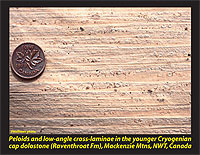 | 4.15:
Detail of peloidal cap dolostone with low-angle cross-lamination, Ravensthroat
Formation, NW Canada. Macropeloidal texture is characteristic of cap dolostones
in Brazil, Canada, NW China, Namibia and Svalbard.
|
|
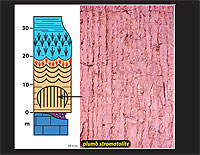 | 4.16:
Plumb (tubular) stromatolite in the Keilberg Member cap dolostone, Namibia.
|
|
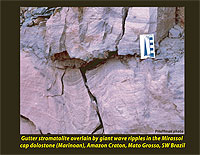 | 4.17:
Gutter stromatolite overlain by giant wave ripples in the Mirassol cap
dolostone,
SW Brazil.
|
|
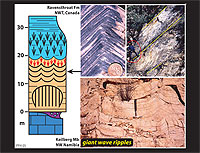 | 4.18:
Giant wave ripples in the Keilberg cap dolostone (below), NW Namibia and
the
Raventhroat cap dolostone (above), NW Canada (cross-section, left; synoptic
morphology, right).
|
|
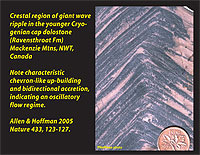 | 4.19:
Cross-section of the crest of a giant wave ripple in the Ravensthroat cap
dolostone,
NW Canada, showing characteristic bidirectional laminae and chevron-like
up-building. Coin is 2 cm in diameter.
|
|
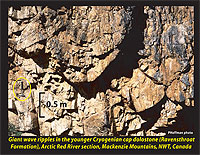 | 4.20:
Giant wave ripples in the Ravensthroat cap dolostone, NW Canada, showing
characteristic
wavelength ~1.5 m and synoptic relief ~0.35 m.
|
|
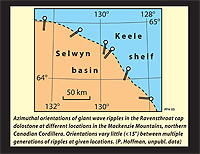 | 4.21:
Azimuthal orientations of giant wave ripples in the Ravensthroat cap dolostone
at
different locations near the contemporaneous shelf-slope break in the Mackenzie
Mountains, northern Canadian Cordillera. Orientations in Namibia are also
subnormal to the shelf-slope break.
|
|
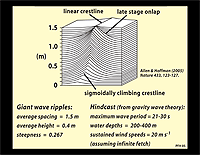 | 4.22:
Characteristic development of giant wave ripples in younger Cryogenian
(Marinoan) cap
dolostones in Canada, Namibia, Svalbard, Australia and Brazil.
|
|
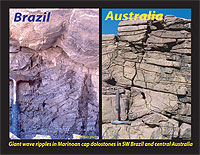 | 4.23:
Giant wave ripples in Marinoan cap dolostones in SW Brazil (cross-section
and
morphological cast) and central Australia.
|
|
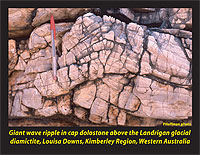 | 4.24:
Giant wave ripple in the Landrigan (Marinoan?) cap dolostone, Louisa Downs,
Kimberley
Region, Western Australia.
|
|
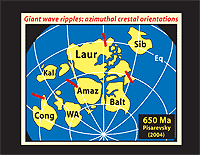 | 4.25:
Tentative paleogeographic reconstruction of continents in the southern
hemisphere at ~650 Ma (after Murphy et al., 2004) showing regional average
azimuthal paleo-orientations (red bars) of the crestlines of giant wave
ripples in 635-Ma cap dolostones in NW Canada, East Svalbard, SW Brazil
and NW Namibia (Paul Hoffman unpublished observations).
|
|
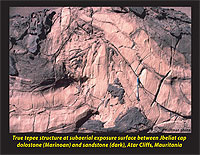 | 4.26:
True tepee structure (cross-section of pressure-ridge caused by the crystallization
force of intergranular evaporite) marking the subaerial exposure surface
at the top of the cap dolostone above continental tillite of the younger
Cryogenian(?) Jbéliat (Bthaat Ergil) Group, Adrar, Mauritania, West
Africa.
|
|
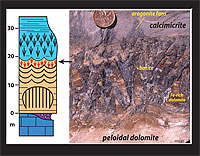 | 4.27:
Sea-floor barite at the top of the Raventhroat cap dolostone, Shale Lake
section,
Mackenzie Mountains, NW Canada. Barite, variably pseudomorphosed by calcite),
occurs throughout the southern Mackenzie Mountains at the precise transition
from peloidal dolostone to calcite micrite (with former aragonite crystal
fans).
|
|
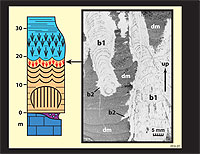 | 4.28:
Thin section of sea-floor barite from the Ravensthroat cap dolostone, NW
Canada.
Note growth layers in 1st-generation barite (b1) "fingers",
and step-outs of 2nd-generation barite (b2) on laminae of peloidal dolostone
(dm) deposited between the barite fingers. The b1 barite fingers must therefore
have projected above the sediment-water interface and were precipitated
directly from seawater, unlike most sedimentary barite which precipitates
from pore-waters during diagenesis.
|
|
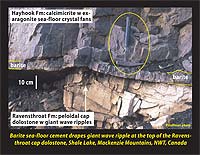 | 4.29:
Sea-floor barite crust drapes a giant wave ripple at the top of the Ravensthroat
cap dolostone, Shale Lake section, Mackenzie Mountains, Canada. Barite
is directly overlain by micritic limestone with crystal fans of former
aragonite sea-floor cement.
|
|
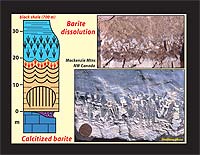 | 4.30:
Transitions from Ravensthroat cap dolostone to Hayhook cap limestone in
which the sea-floor barite cements (pseudo-stromatolites) have been replaced
by calcite (below) and a solution-collapse mini-breccia (above). Barite
replacement and dissolution probably occurred under the influence of reducing
groundwaters percolating downward from the directly overlying black pyritic
shale (>700 m thick) of the Sheepbed Formation. Note palimpsest growth
laminae in the calcitized barite pseudo-stromatolites.
|
|
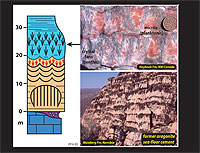 | 431:
Crystal fans of pseudomorphosed aragonite sea-floor cement in micritic
limestones
above the younger Cryogenian cap dolostones in Namibia (below) and Canada
(above).
|
|
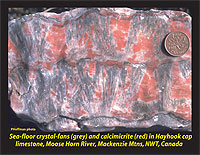 | 4.32:
Former aragonite crystal fans in calcite micrite of the Hayhook Formation
in the
younger Cryogenian cap-carbonate sequence, Moose Horn River section, Mackenzie
Mountains, Canada.
|
|
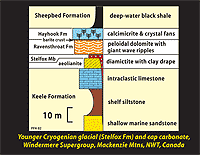 | 4.33:
Stratigraphic sequence associated with the younger Cryogenian glaciation
(Stelfox Member,
Ice Brook Formation) in the southern Mackenzie Mountains, Canada.
|
|
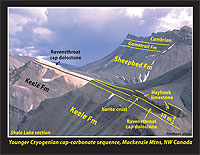 | 4.34:
Shale Lake section of the Cryogenian-Ediacaran transition in the Mackenzie
Mountains, Canada.
|
|
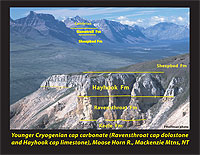 | 4.35:
Ravensthroat cap dolostone and Hayhook liimestone of the younger Cryogenian
(Marinoan) cap-carbonate sequence, Moose Horn River section, Mackenzie
Mountains, Canada.
|
|
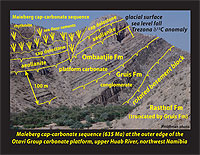 | 4.36:
Stratigraphic sequence associated with the younger Cryogenian glaciation
at the edge of the Otavi Group carbonate platform in NW Namibia.
|
|
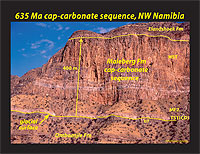 | 4.37:
Complete post-glacial cap-carbonate sequence (Maieberg Formation) associated
with the younger Cryogenian glaciation on the Otavi Group carbonate platform
near Obaatjie, NW Namibia. TST (CD), Keilberg Member cap dolostone; MFZ,
limestone rhythmite of the maximum flooding stage; HST, flaggy limestone
and dolostone grainstone of the highstand systems tract.
|
|
|
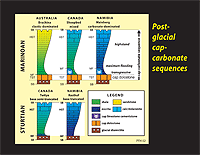 | 4.38:
Surtian and Marinoan cap-carbonate sequences in clastic-dominated, mixed
clastic-carbonate,
and carbonate-dominated successions on tectonically-subsiding shelves and
platforms.
|
|
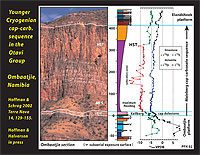 | 4.39:Carbon
(δ13C) and oxygen (δ18O) isotopic profiles
of the younger Cryogenian cap-carbonate sequence and the pre-glacial Trezona
anomaly, Otavi Group carbonate platform
near Ombaatjie, NW Namibia.
|
|
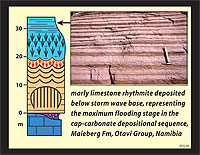 | 4.40:
Marly limestone rhythmite in the maximum flooding stage of the younger
Cryogenian (Marinoan) cap-carbonate sequence (Maieberg Formation), Otavi
Group carbonate platform near Ombaatjie, NW Namibia.
|
|
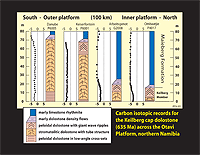 | 4.41:
Sedimentary facies and carbon isotopes of the Keilberg cap dolostone across
the Otavi carbonate
platform in northern Namibia.
|
|
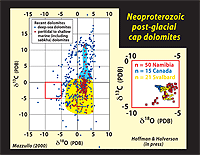 | 4.42:
Carbon/oxygen isotope cross-plot for Holocene "organogenic" secondary
dolomites (Mazzullo, 2000). Large variations in carbon isotopes are caused
by production of 13C-enriched CO2 during methanogenesis
and 13C-depleted
CO2 during bacterial sulfate reduction. This contrasts with
tightly clustered isotopic data from 635-Ma cap dolostones in Namibia,
Svalbard and NW Canada,
which are interpreted to reflect equilibrium with contemporaneous seawater.
|
|
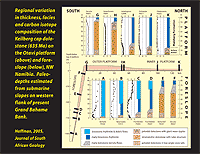 | 4.43:
Regional variation in thickness, facies and carbon isotopic composition
of the younger Cryogenian (Marinoan) cap dolostone on the Otavi Group carbonate
platform (above) and foreslope (below), Namibia.
|
|
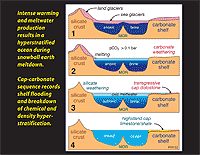 | 4.44:Transient
ocean hyperstratification accompanying the meltdown of a snowball earth.
|
|
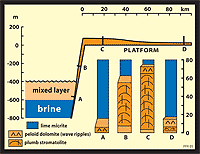 | 4.45:
Early stage in the flooding of the Otavi Group carbonate platform accompanying
the meltdown of the younger Cryogenian snowball earth in 635 Ma.
|
|
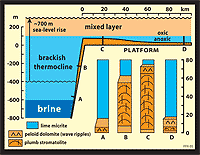 | 4.46:
Later stage in the flooding of the Otavi Group carbonate platform accompanying
the meltdown of the younger Cryogenian snowball earth in 635 Ma.
|
|
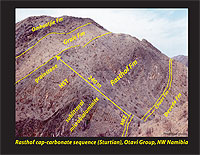 | 4.47:
The complete cap-carbonate sequence (Rasthof Formation) of the older Cryogenian
(Sturtian) glaciation (Chuos Formation), Otavi Group platform, near Omukutu,
upper Hoanib River, NW Namibia. Top of cap-carbonate sequence is the first
subaerial exposure surface above the glacial.
|
|
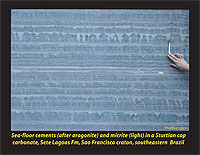 | 4.48:
Sea-floor cement (pseudomorphosed aragonite crystal fans) in the Sete Lagoas
cap-carbonate sequence above the older Cryogenian(?) glacials (Macaubas
Formation) in the Bambuí Group on the Sao Francisco craton, SE Brazil.
|
















































